
Agile Software Development Team Structure
Contents
Agile software development has become a quality standard in the tech industry, transforming how IT projects are managed and executed. Understanding the agile software development team structure is crucial for business owners experiencing the sophistication of application architecting. This article observes the definition, types, benefits, and tips to assemble an agile developers team, making this seemingly complex topic accessible to a broader audience.
Why an Agile Software Dev Team is More Efficient than Traditional
At its core, an agile software development team structure is a collaborative and flexible framework that adapts to the ever-changing demands of soft creation. Agile embraces iterative processes, continuous feedback, and a customer-centric mindset, unlike traditional approaches. Its goal is to deliver high-quality software more efficiently and responsively.
Agile teams thrive on a flexible and adaptive mindset, allowing individuals to contribute beyond their designated roles. This adaptability contrasts sharply with the rigid structures of traditional teams, fostering collaboration and innovation across diverse skill sets.
While traditional teams rely on hierarchical structures and top-down decision-making, Agile teams leverage cooperation and self-management. Agile encourages rapid and collective decision-making in response to real-time feedback, emphasizing the team’s collective performance over individual contributions and fast reaction to changes. Moreover, traditional teams adhere to defined job titles and roles, often limiting the versatility of team members. Agile prioritizes skills and abilities over formal titles, fostering a culture where cross-functional talents contribute collaboratively to project success.
Traditional dev teams follow a linear, phase-based process, completing each step before moving on. In contrast, Agile teams operate in sprints, enabling simultaneous progress across all stages. This iterative approach ensures quicker delivery of workable products and seamless adaptation to changing requirements. In addition, the variety and excitement of tasks reduce the risk of developer burnout and contribute to the professional fulfillment of IT specialists.
Agile’s adaptability shines when unexpected challenges arise. The ability to multitask and address issues swiftly is exemplified in Agile teams, allowing for quick course corrections. Various Agile methodologies, such as Scrum, Kanban, Lean Development, Crystal, and Extreme Programming, offer specific advantages in continuous improvement, shorter cycle times, adaptability to change, and efficient task organization. Each methodology aligns with Agile principles, promoting a holistic and responsive development approach.
The benefits of an Agile approach, including product quality, customer satisfaction, faster ROI, lower risks, efficiency, and adaptability, contribute to the success and efficiency of Agile software development teams.

Traditional team vs agile team in software development
Main types of Agile development team structures
Agile dev teams can take on various forms based on the project’s needs, organization, and methodology. Here are the main types of Agile software development team structures you may meet at the market:
- Cross-functional teams
Cross-functional teams are a fundamental concept in Agile. Each team comprises individuals with diverse skills necessary to complete the development process. Team members can collectively handle tasks from ideation to development, testing, and deployment. This structure promotes collaboration, reduces department handoffs, and allows faster and more efficient development cycles. - Feature teams
Feature teams are organized around specific features of a product rather than isolated or standalone tasks. Team members possess the skills to develop end-to-end features, enhancing ownership and accountability. This structure enables a more customer-centric approach as teams focus on delivering complete functionality that provides value to users. - Component teams
In contrast to feature teams, component teams specialize in particular technical components or layers of an IT system (e.g., frontend, backend, database). This approach allows for deep specialization and expertise in specific technologies or domains; however, external coordination may be required to deliver complete features. - Self-organizing teams
Self-organizing teams have the autonomy to make decisions about how they work and how they meet their objectives. Their members cooperate to define tasks, allocate work, and continuously improve their processes. This methodology enhances team motivation, creativity, and adaptability. Teams take ownership of their work and are more responsive to changes. - Scaling Agile teams
Multiple Agile development teams may need to collaborate on large-scale, enterprise-level projects. Frameworks like SAFe (Scaled Agile Framework) or LeSS (Large-Scale Scrum) provide structures for coordinating multiple teams, ensuring alignment and synchronization.
The choice of a specific structure depends on factors such as project complexity, team expertise, and organizational goals. Agile methodologies encourage adaptability, allowing developers to evolve their structures to deliver high-quality software efficiently. For instance, Scrum is a popular Agile framework that defines specific roles within a team, including a Product Owner, Scrum Master, and Development Team. The scrum development team is usually cross-functional and self-organizing. Kanban is another Agile framework that visualizes work, limits work in progress, and maximizes flow. Teams using Kanban often follow a continuous delivery model.
How to Select a Team Structure for Agile Software Development
The right team structure for software product creation is crucial for project success. To achieve this, follow these practical tips:
- Understanding project needs and balancing roles is foundational. Consider the critical role of a product owner from a visionary perspective. Additionally, consider the scope of work, timeframes, and budget when structuring the team.
- Take an individualized approach to team structuring. Conduct calls with key stakeholders to understand client needs and tailor the team structure based on client challenges. Emphasize the assessment of each professional’s fit for the project.
- Prioritize collaboration and Agile principles. Ensure collaborative relationships within the team, including product managers, UX designers, developers, QA engineers, and a Team Lead. Follow Agile principles, promoting self-management, dedication to one project, and cross-functional teams.
- Stay flexible and adaptive. Accentuate the flexibility of Agile teams, advocating for adaptability to change and treating individuals as humans. Embrace changes, focus on constant learning, and promote a team adaptation culture.
- Effective communication and goal awareness are critical. Communicate goals clearly to ensure team members understand the value of their work. Keep effective collaboration through regular and personalized communication to build trust within the team.
- Assess skills and experience to build a balanced team. Avoid mistakes in selecting developers by balancing expertise levels. Include senior and less experienced members to create a mix of skills and perspectives. When building an Agile team, highlight the importance of finding the right people through co-location, motivation, and cohesion.
- Choose Agile methodologies and tools. Select Agile methods like Scrum or Kanban based on project characteristics and use Agile software tools for streamlined management.
- Be patient in the team-building process. Avoid rushing it, focusing on continuous learning, smaller improvements, and achievements. Understand the fundamentals of building an Agile team, focusing on collaboration, a common goal, distribution of duties, and teamwork.
By integrating these recommendations, you can tailor a suitable structure aligned with the unique requirements of your software development project, fostering collaboration, flexibility, and effective communication among team members. Our practical experience of creating custom software for 14 years confirms this.
Develop Your Custom Software Application with Agile Teams of Academy Smart
We are an outstaffing IT agency, offering access to a vast pool of skilled programmers. Our services streamline your hiring process, handling everything from resume screening to technical interviews, ensuring you secure the ideal candidates.
For our clients, we provide:
- Expert guidance derived from in-depth technical analysis of customer needs and market niche software requirements.
- Flexible cooperation models: dedicated teams, subcontracting, or staff augmentation.
- High qualifications and efficiency of our project development team.
- Leveraging robust and modern technologies for software development.
- A dedicated and creative approach to problem-solving, coupled with a responsible work ethic.
Contact us to leverage our extensive knowledge of the latest technology stacks and elevate your enterprise software solutions.
Frequently Asked Questions: Agile Software Development Team Structure
How to introduce Agile to a team software development?
Initiate a comprehensive training program to familiarize team members with Agile principles, practices, and methodologies. Encourage a culture of collaboration, iterative development, and continuous improvement to foster the seamless adoption of Agile methods.
How should scrum teams plan work to develop software applications effectively?
Scrum teams plan work by organizing sprint planning meetings, prioritizing backlog items, estimating task complexity, and collaboratively committing to a set of user stories for the upcoming sprint. Regular reviews and retrospectives further enhance adaptability and continuous improvement in the software development process.
Book a free consultation

Reach out to start talking today!












